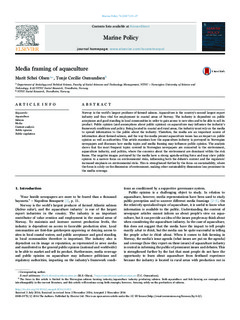| dc.contributor.author | Olsen, Marit Schei | |
| dc.contributor.author | Osmundsen, Tonje | |
| dc.date.accessioned | 2017-10-25T06:39:03Z | |
| dc.date.available | 2017-10-25T06:39:03Z | |
| dc.date.created | 2017-01-05T15:05:19Z | |
| dc.date.issued | 2017 | |
| dc.identifier.citation | Marine Policy. 2017, 76 19-27. | nb_NO |
| dc.identifier.issn | 0308-597X | |
| dc.identifier.uri | http://hdl.handle.net/11250/2461972 | |
| dc.description.abstract | Norway is the world's largest producer of farmed salmon. Aquaculture is the country's second largest export industry and thus vital for employment in coastal areas of Norway. The industry is dependent on public acceptance and good standing in local communities in order to gain access to new sites and to be able to sell its product. Public opinion (and assumptions about public opinion) on aquaculture may influence the industry's framework conditions and policy. Being located in coastal and rural areas, the industry must rely on the media to spread information to the public about the industry. Therefore, the media are an important source of information about farmed salmon, and the way the media present aquaculture issues has an impact on public opinion as well as authorities. This article examines how the aquaculture industry is portrayed in Norwegian newspapers and discusses how media topics and media framing may influence public opinion. The analysis shows that the most frequent topics covered in Norwegian newspapers are connected to the environment, aquaculture industry, and politics, where the concerns about the environment are dominant within the risk frame. The negative images portrayed by the media have a strong agenda-setting force and may skew public opinion to a narrow focus on environmental risks, influencing both the debate's content and the regulators’ increased emphasis on environmental risks. This is strengthened further by the focus on sustainability, where the focus is solely on the dimension of environment, making other sustainability dimensions less prominent in the media coverage. | nb_NO |
| dc.language.iso | eng | nb_NO |
| dc.publisher | Elsevier | nb_NO |
| dc.rights | Navngivelse 4.0 Internasjonal | * |
| dc.rights.uri | http://creativecommons.org/licenses/by/4.0/deed.no | * |
| dc.subject | Havbruk | nb_NO |
| dc.subject | Aquavulture | nb_NO |
| dc.title | Media framing of aquaculture | nb_NO |
| dc.type | Journal article | nb_NO |
| dc.type | Peer reviewed | nb_NO |
| dc.description.version | publishedVersion | nb_NO |
| dc.subject.nsi | VDP::Statsvitenskap og organisasjonsteori: 240 | nb_NO |
| dc.subject.nsi | VDP::Political science and organisational theory: 240 | nb_NO |
| dc.source.pagenumber | 19-27 | nb_NO |
| dc.source.volume | 76 | nb_NO |
| dc.source.journal | Marine Policy | nb_NO |
| dc.identifier.doi | 10.1016/j.marpol.2016.11.013 | |
| dc.identifier.cristin | 1421826 | |
| dc.relation.project | Norges forskningsråd: 234139 | nb_NO |
| dc.description.localcode | © 2016 The Authors. Published by Elsevier Ltd. This is an open access article under the CC BY license (http://creativecommons.org/licenses/by/4.0/). | nb_NO |
| cristin.unitcode | 194,67,25,0 | |
| cristin.unitname | Institutt for sosiologi og statsvitenskap | |
| cristin.ispublished | true | |
| cristin.fulltext | original | |
| cristin.qualitycode | 1 | |

